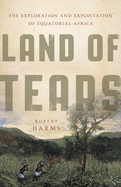
Historian Robert Harms brings his considerable expertise to bear on the bloody means by which the Congo River Basin was exploited for commercial gain in Land of Tears: The Exploration and Exploitation of Equatorial Africa. The Congo River Basin, rich in rubber and more, was largely dense rain forest that covered parts of six modern-day nations. As he did in The Diligent, his excellent history of the slave trade, Harms follows a few important--and deeply flawed--individuals who helped pave the way for exploitation on a massive scale.
Land of Tears begins in the 1870s, when the region's difficult landscape was just beginning to be scouted by traders, raiders and explorers from Europe and Zanzibar. Harms is skilled at interpreting the deeply biased and self-serving accounts of explorers like Henry Morton Stanley, showing how his 1875-1876 expedition to find the source of the Nile turned into a remarkably violent trip down the Congo River. The Zanzibari trader Tippu Tip plays a major role in the narrative and in Harms's argument that violence, slavery and the ivory trade were deeply intertwined. By following the ivory back to a factory manufacturing piano keys in Connecticut, Harms demonstrates that an already globalized economy fueled and benefited from the bloody work of people like Tippu Tip.
Land of Tears tracks the pursuit of profit at the expense of human life to its apotheosis in the era of "red rubber." Individuals like Stanley and Tippu Tip had diverse motivations, but Harms is clear-eyed about the brutal extractive system they helped create. --Hank Stephenson, manuscript reader, the Sun magazine

